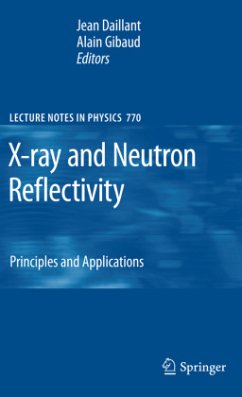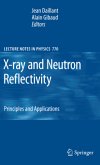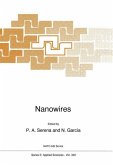This book presents a comprehensive introduction to X -ray and neutron reflectivity techniques and illustrates them with many examples. For the second edition, all chapters have been thoroughly revised, updated and, where appropriate, suitably augmented.
ways in which the magnetic interaction between neutrons and magnetic moments can yield information on the magnetization densities of thin ?lms and multilayers. I commend the organizers for having organized a group of expert lecturers to present this subject in a detailed but clear fashion, as the importance of the subject deserves. Argonne, IL S. K. Sinha Contents 1 The Interaction of X-Rays (and Neutrons) with Matter . . . . . . . . . . . . . . 1 F. de Bergevin 1. 1 Introduction . . . . . . . . . . . . . . . . . . . . . . . . . . . . . . . . . . . . . . . . . . . . . . 1 1. 2 Generalities and De?nitions . . . . . . . . . . . . . . . . . . . . . . . . . . . . . . . . 2 1. 3 From the Scattering by an Object to the Propagation in a Medium . 14 1. 4 X-Rays . . . . . . . . . . . . . . . . . . . . . . . . . . . . . . . . . . . . . . . . . . . . . . . . . . 26 1. 5 X-Rays: Anisotropic Scattering . . . . . . . . . . . . . . . . . . . . . . . . . . . . . . 47 1. A Appendix: the Born Approximation . . . . . . . . . . . . . . . . . . . . . . . . . . 54 References . . . . . . . . . . . . . . . . . . . . . . . . . . . . . . . . . . . . . . . . . . . . . . . . . . . . . 56 2 Statistical Aspects of Wave Scattering at Rough Surfaces . . . . . . . . . . . . 59 A. Sentenac and J. Daillant 2. 1 Introduction . . . . . . . . . . . . . . . . . . . . . . . . . . . . . . . . . . . . . . . . . . . . . . 59 2. 2 Description of Randomly Rough Surfaces . . . . . . . . . . . . . . . . . . . . . 60 2. 3 Description of a Surface Scattering Experiment, Coherence Domains . . . . . . . . . . . . . . . . . . . . . . . . . . . . . . . . . . . . . . . . . . . . . . . . . 67 2. 4 Statistical Formulation of the Diffraction Problem . . . . . . . . . . . . . . 72 2. 5 Statistical Formulation of theScattered Intensity Under the Born Approximation . . . . . . . . . . . . . . . . . . . . . . . . . . . . . . . . . . . . . . . . . . . 79 References . . . . . . . . . . . . . . . . . . . . . . . . . .. . . . . . . . . . . . . . . . . . . . . . . . . . . 84 3 Specular Re?ectivity from Smooth and Rough Surfaces . . . . . . . . . . . . . 85 A. Gibaud and G. Vignaud 3. 1 The Re?ected Intensity from an Ideally Flat Surface . . . . . . . . . . . . 85 3. 2 X-Ray Re?ectivity in Strati?ed Media . . . . . . . . . . . . . . . . . . . . . . . . 98 3. 3 From Dynamical to Kinematical Theory . . . . . . . . . . . . . . . . . . . . . . 107 3. 4 In?uence of the Roughness on the Matrix Coef?cients . . . . . . . . . . 111 3. A Appendix: The Treatment of Roughness in Specular Re?ectivity . . 113 3. B Appendix: Inversion of re?ectivity data . . . . . . . . . . . . . . . . . . . . . . .
ways in which the magnetic interaction between neutrons and magnetic moments can yield information on the magnetization densities of thin ?lms and multilayers. I commend the organizers for having organized a group of expert lecturers to present this subject in a detailed but clear fashion, as the importance of the subject deserves. Argonne, IL S. K. Sinha Contents 1 The Interaction of X-Rays (and Neutrons) with Matter . . . . . . . . . . . . . . 1 F. de Bergevin 1. 1 Introduction . . . . . . . . . . . . . . . . . . . . . . . . . . . . . . . . . . . . . . . . . . . . . . 1 1. 2 Generalities and De?nitions . . . . . . . . . . . . . . . . . . . . . . . . . . . . . . . . 2 1. 3 From the Scattering by an Object to the Propagation in a Medium . 14 1. 4 X-Rays . . . . . . . . . . . . . . . . . . . . . . . . . . . . . . . . . . . . . . . . . . . . . . . . . . 26 1. 5 X-Rays: Anisotropic Scattering . . . . . . . . . . . . . . . . . . . . . . . . . . . . . . 47 1. A Appendix: the Born Approximation . . . . . . . . . . . . . . . . . . . . . . . . . . 54 References . . . . . . . . . . . . . . . . . . . . . . . . . . . . . . . . . . . . . . . . . . . . . . . . . . . . . 56 2 Statistical Aspects of Wave Scattering at Rough Surfaces . . . . . . . . . . . . 59 A. Sentenac and J. Daillant 2. 1 Introduction . . . . . . . . . . . . . . . . . . . . . . . . . . . . . . . . . . . . . . . . . . . . . . 59 2. 2 Description of Randomly Rough Surfaces . . . . . . . . . . . . . . . . . . . . . 60 2. 3 Description of a Surface Scattering Experiment, Coherence Domains . . . . . . . . . . . . . . . . . . . . . . . . . . . . . . . . . . . . . . . . . . . . . . . . . 67 2. 4 Statistical Formulation of the Diffraction Problem . . . . . . . . . . . . . . 72 2. 5 Statistical Formulation of theScattered Intensity Under the Born Approximation . . . . . . . . . . . . . . . . . . . . . . . . . . . . . . . . . . . . . . . . . . . 79 References . . . . . . . . . . . . . . . . . . . . . . . . . .. . . . . . . . . . . . . . . . . . . . . . . . . . . 84 3 Specular Re?ectivity from Smooth and Rough Surfaces . . . . . . . . . . . . . 85 A. Gibaud and G. Vignaud 3. 1 The Re?ected Intensity from an Ideally Flat Surface . . . . . . . . . . . . 85 3. 2 X-Ray Re?ectivity in Strati?ed Media . . . . . . . . . . . . . . . . . . . . . . . . 98 3. 3 From Dynamical to Kinematical Theory . . . . . . . . . . . . . . . . . . . . . . 107 3. 4 In?uence of the Roughness on the Matrix Coef?cients . . . . . . . . . . 111 3. A Appendix: The Treatment of Roughness in Specular Re?ectivity . . 113 3. B Appendix: Inversion of re?ectivity data . . . . . . . . . . . . . . . . . . . . . . .








